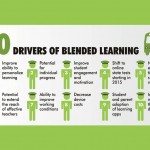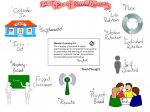
“The Flipped Classroom Turns Around an At-Risk, Failing School” by Greg Green, Principal at Clintondale High School, was originally published on Getting Smart.
As a principal of Clintondale High School, I’ve witnessed firsthand the struggles that a school must endure to educate at-risk students. Many of the students at Clintondale are faced with obstacles that hinder their education: 74 percent of our 570 students qualify for the free or reduced lunch program, 38 percent receive special education services and 70 percent are a racial minority. Like many schools around the country, our students were failing their classes. In fact, two years ago our failure rate was 61 percent in some cases.
After studying forty of our teachers and interviewing numerous students for one year, we discovered that on average, our students were given a mere 32 seconds of one-on-one support and instruction in each class. As a principal, bearing witness to these failures was heartbreaking and frustrating.
In 2010, we decided that something needed to be dramatically done to help each student succeed in school and beyond. As a community, we knew we needed to flip our education model to eliminate the frustration that all stakeholders had when doing homework without support and simply help our students receive more individual support from teachers in school during the learning and practicing process.
Our devoted staff, willing to try new approaches, began to assign video lectures and shortened lectures for homework and spend class time working with students on their homework. This reversed approach throughout education is known as “the flipped model”, whereby class time is spent reviewing problem sets and questions, and students watch videos of lectures at home. This model allows students to have one-on-one access to teachers when they need help or have questions. After applying for a grant from TechSmith, a local Michigan company, we received free licenses to Camtasia, lecture capture software that would allow our teachers to record their lessons. In addition to providing us with some simple software solutions, TechSmith partnered with us to help us implement this blended technology approach.
As a first step, we implemented the flipped class approach in a single classroom. The trial period lasted 20 weeks. The results were astounding: by the end of class, all 23 students had passed the course which led to an 11 percent reduction in failure rate. After witnessing this success, we implemented the model in six ninth grade classrooms for an entire school year. After the year, our ninth grade failure rate was reduced by 30 percent. Next, we evaluated the flipped model to prepare students for the math portion of the Michigan Merit Exam/ACT. When we received the scores for 114 students, there was an 8 percent increase in student proficiency in math while student proficiency in the other subjects stayed the same or decreased.
The flipped approach was so successful among our students that we decided to implement the model in the entire school. Two years ago our failure rate was 61.2 percent; after just one quarter, the school-wide failure rate dropped to just below 10 percent – a reduction of 50.4 percent!
A matter of fact, we have seen an increase in our state standardized tests scores with a group that two years ago had failed miserably. We even got off the PLA List within one year of flipping our school!
By using a flipped model, we have put the best instruction in front of all students in a way that matches their learning style and life circumstances to give them the attention they need to be successful. This approach also allowed us to properly integrate current technologies, guarantee and streamline our curriculum, provide educational services regardless of absences and share staff resources. In essence, the flipped class model has allowed us to give students access to the best possible materials, resources and education.
Image attribution flickr user MSU Research Library


